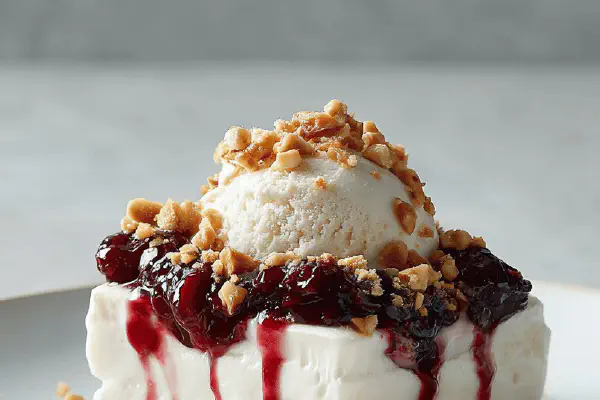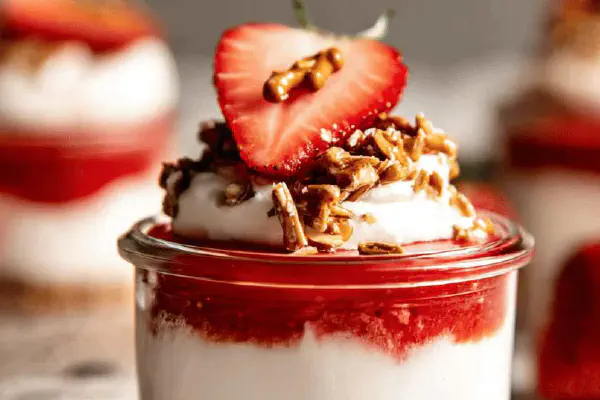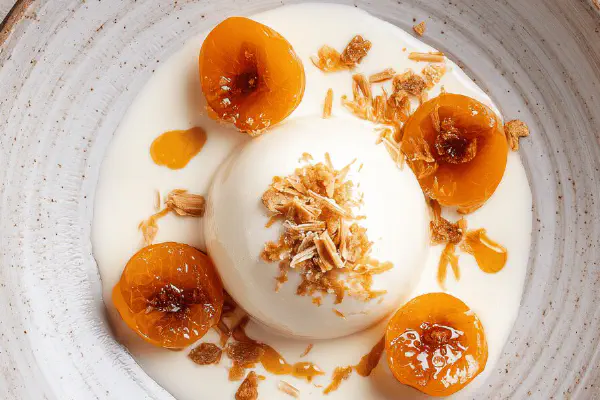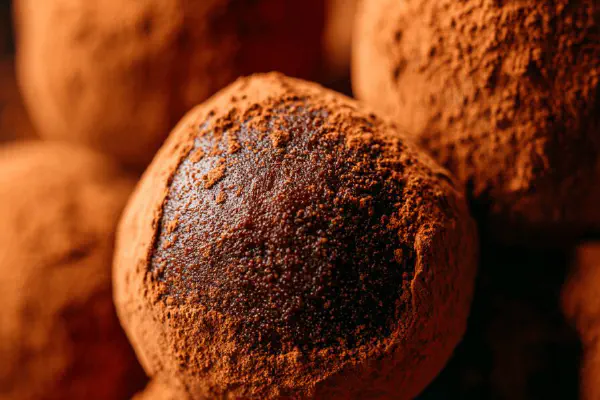Peanut Butter Jelly Sundaes

By Emma
Certified Culinary Professional
Ingredients
Peanut Butter Cream
- 280 ml (1 ¼ cups) unsweetened almond milk or regular milk
- 90 g (6 tbsp) natural peanut butter no sugar
- 30 g (2 tbsp) maple syrup or agave
- 1/8 tsp salt
Toppings
- 450 ml (1 ¾ cups) vanilla frozen yogurt or dairy-free coconut ice cream
- 200 g (¾ cup) roasted berry jam (blueberry or raspberry preferred)
- 30 g (3 tbsp) toasted sunflower seeds or crushed peanuts
About the ingredients
Method
Making the Peanut Butter Cream
- 1. Pour milk, peanut butter, maple syrup, and salt into small heavy saucepan. Use medium-low heat to avoid early scorching. Whisk continuously until smooth blend forms and just starts to thicken, about 7 to 10 minutes. Look for thick ribbons forming on the whisk when lifted. Avoid boiling vigorously. If bubbles appear, reduce heat immediately to steady simmer. Thickness will be similar to loose pudding—coats the back of a spoon but still pourable.
- 2. Simmer gently for 2 more minutes, whisking constantly so it doesn't stick. The subtle fluffiness comes from gentle cooking—overcooking thins it or makes it grainy. Immediately transfer to a glass container. Cool at room temp until lukewarm (feels neutral on wrist). Then cover and refrigerate at least 3 hours or overnight to set fully. Cold resting crucial to thicken properly without added gelatin or starch. Cream will stiffen to spreadable consistency.
Assembly
- 3. Place four dessert glasses or bowls into freezer to chill 10 minutes before serving. Cold glass helps retain dessert texture.
- 4. Scoop frozen yogurt or ice cream into each glass—aim for even layer. Spoon roasted berry jam generously—note drying or caramelizing jam a day ahead adds deep flavor, but fresh works fine too. Then dollop peanut butter cream over jam, spreading lightly to create distinct layers.
- 5. Finish with sprinkling toasted sunflower seeds or crushed nuts. Avoid stale or raw nuts; dry-toast in pan until warm and nutty aroma releases, about 2 minutes. Cool before adding for crunch without oiliness.
- 6. Serve immediately before ice cream melts into layers or keep briefly chilled (max 10 minutes). The contrast between creamy cold base, sweet tangy jam, and nutty crunch is key for mouthfeel.
Cleanup and Variations
- 7. If peanut butter cream looks too thick after refrigeration, whisk slightly to restore creaminess before layering. Adding a splash of milk while warming gently with whisk revives if too firm.
- 8. Substitute sunflower seed butter for peanut butter if allergy concerns. Use strawberry or mixed berry jam instead of roasted jam—roasting jam intensifies caramel notes but raw bright fruit flavor is interesting alternative.
- 9. For more crunch, add a crumb topping made from crushed oat cookies or gluten free granola mixed with 1 tsp melted coconut oil, toasted slightly before cooling and sprinkling over sundae.
Cooking tips
Chef's notes
- 💡 Whisk peanut butter and milk on medium-low, no rush; ribbons form thick but pourable. Scorching kills silkiness—listen to quiet whisk rhythm, no loud bubbles. When thick enough coat spoon back, stop heat fast. Cool uncovered till lukewarm, skin thin or none, odd chill after. Refrigerate minimum 3 hours fully set, overnight best for spreadability.
- 💡 Cold glassware slows ice cream melting, keeps layers sharp. Prefreeze glasses 10 minutes minimum. Frozen yogurt melts slower, tang adds bite without heaviness like ice cream. Dollop jam warmed slightly or fresh—dry roast jam day before for caramel notes but raw berry punch works too. Spread gently to keep layers distinct, no swirls.
- 💡 Use natural peanut butter only, no added oils or sugars. Oily variants ruin thickening, gummy or too thin cream. Maple syrup soft sweetness, alternatives like agave okay but thin cream slightly. Milk choice changes texture: almond milk adds nuttiness, cow’s milk richer but watch for scalding and color change. Stir constant, never stop till ribbons form.
- 💡 Toast nuts or seeds dry in pan until warm aroma jumps; avoid oil, prevents sogginess and bitterness. Cool nuts before adding to sundae. Toasted sunflower seeds safest allergy swap. Swap peanut butter with sunflower seed butter for nut-free. Jam swap strawberry or mixed berries—roasting shifts flavor depth, fresh bright acids differ.
- 💡 If cream thickens too hard after fridge, gentle warming with splash milk and whisk revives softness. Do this small batch, stir constant so no lumps form. Adding oat crumble toasted with coconut oil adds crunch and moisture balance; toast crumble before cooling. Layer order matter: yogurt, jam, peanut cream, then nuts top. Serve fast or chill max 10 mins to avoid mixing.
Common questions
How do I know when peanut butter cream is ready?
Look for thick ribbons on whisk, coating spoon back but still pourable. No boil, bubbles quiet. Heat low, whisk fast to avoid lumps. Skin thin when cooling means right temp to fridge.
Can I use other jams or nut butters?
Yes. Mixed berry or strawberry jam fresh or roasted changes flavor note. Sunflower seed butter works as allergen swap but slight taste change. Keep cooking time and temp same, texture shifts slightly with oils.
What if peanut cream is too thick or stiff after chilling?
Warm gently with splash of milk, whisk fast to soften. Avoid overheating or lumps. Can remix before layering without losing texture. Thick means over-set or too cold; little milk thins back fast.
How to store leftovers or prep ahead?
Peanut cream lasts covered in fridge 2-3 days chilled. Keep jam separate if possible. Layered sundae best same day. Glasses can be chilled hours ahead but nuts last crunch best fresh. Do not freeze assembled dessert.



